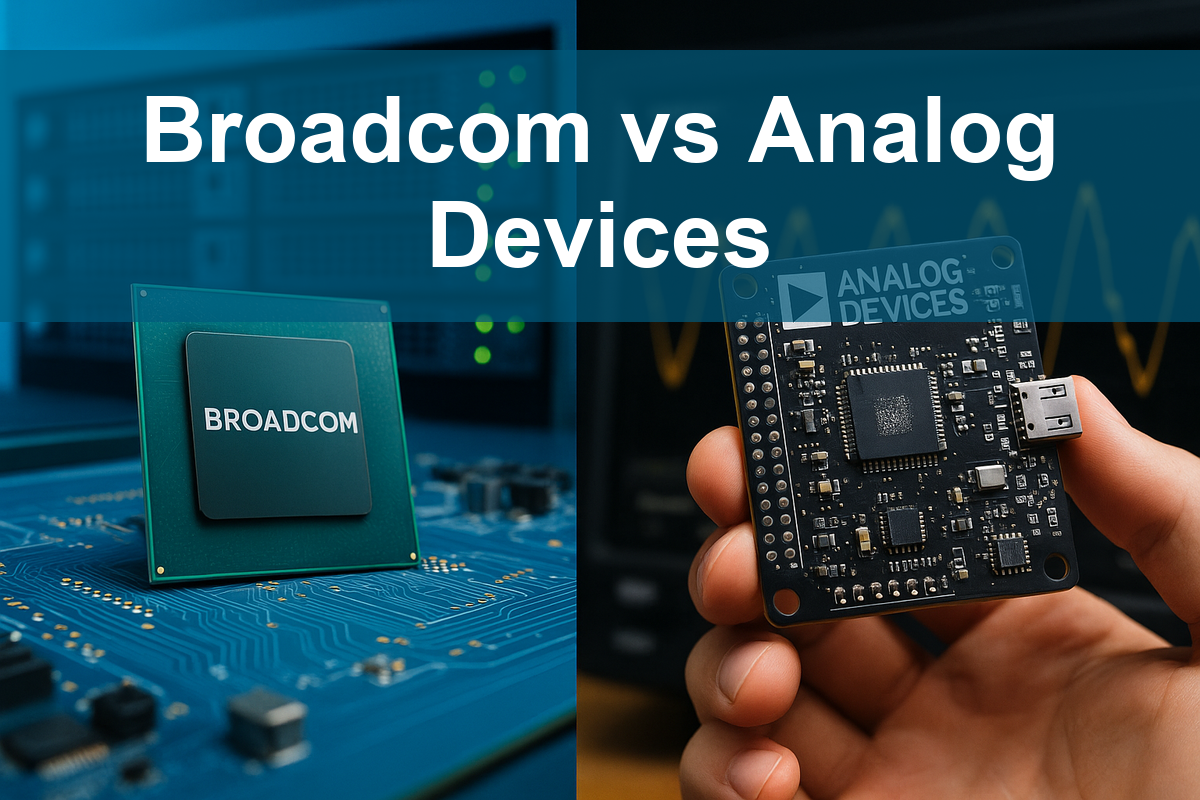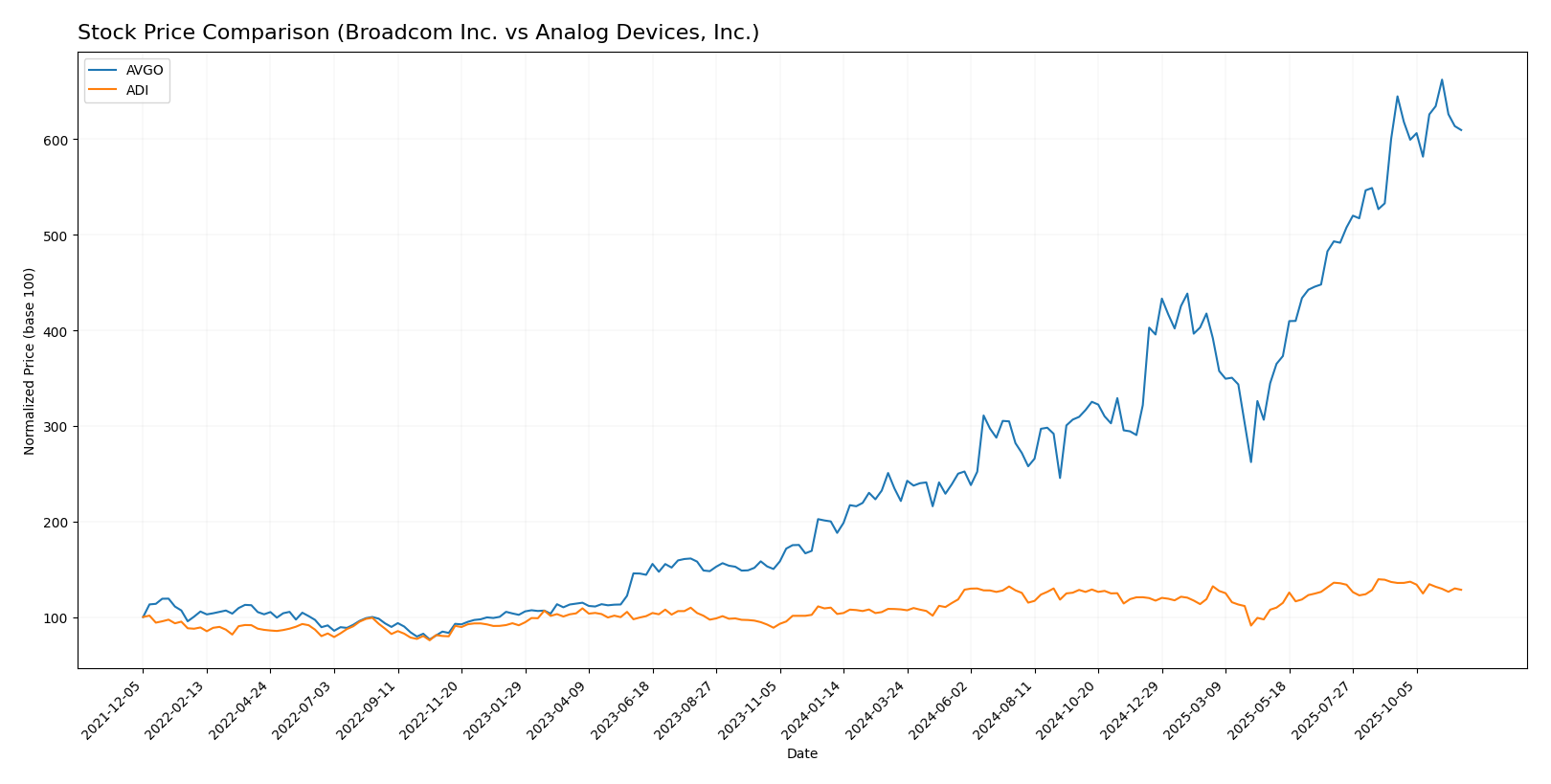In the fast-evolving semiconductor industry, Broadcom Inc. (AVGO) and Analog Devices, Inc. (ADI) stand out as key players, each with distinct strategies and product offerings. Both companies are involved in designing and manufacturing critical components that power various technologies, from telecommunications to automotive systems. As they navigate market challenges and opportunities, this article aims to uncover which company presents a more compelling investment opportunity for savvy investors like you.

Table of contents
Company Overview
Broadcom Inc. Overview
Broadcom Inc. (AVGO) is a leading global technology company that specializes in designing and supplying semiconductor and infrastructure software solutions. Headquartered in San Jose, California, Broadcom operates across four primary segments: Wired Infrastructure, Wireless Communications, Enterprise Storage, and Industrial & Other. The company is recognized for its vast product portfolio, which supports various applications including data center networking, home connectivity, and telecommunications. With a workforce of approximately 37,000 employees, Broadcom emphasizes innovation and integration, making it a pivotal player in the semiconductor industry.
Analog Devices, Inc. Overview
Analog Devices, Inc. (ADI) focuses on designing, manufacturing, and marketing integrated circuits and subsystems that leverage analog and digital signal processing technologies. Based in Wilmington, Massachusetts, the company serves a diverse range of sectors, including automotive, communications, and industrial markets. Analog Devices is known for its high-performance data converters and power management products, which are crucial for converting real-world signals into digital data and vice versa. With around 24,000 employees, Analog Devices has established itself as a key contributor to advancements in electronic applications.
Key Similarities and Differences
Both Broadcom and Analog Devices operate within the semiconductor industry, focusing on advanced technology solutions. However, Broadcom has a broader range of applications and segments, while Analog Devices specializes more in signal processing technologies. Their business models reflect these focuses, with Broadcom leaning towards integrated solutions and Analog Devices emphasizing high-performance components.
Income Statement Comparison
The following table presents a comparison of key income metrics for Broadcom Inc. (AVGO) and Analog Devices, Inc. (ADI) for the most recent fiscal year.
| Metric | Broadcom Inc. (AVGO) | Analog Devices, Inc. (ADI) |
|---|---|---|
| Revenue | 51.57B | 9.43B |
| EBITDA | 23.88B | 4.20B |
| EBIT | 13.87B | 2.10B |
| Net Income | 5.90B | 1.64B |
| EPS | 1.27 | 3.30 |
Interpretation of Income Statement
In the most recent fiscal year, Broadcom reported a significant increase in revenue, jumping to 51.57B from 35.82B in the prior year, while Analog Devices saw a decline from 12.30B to 9.43B. Despite this, ADI’s net income increased to 1.64B, reflecting a stable margin, while AVGO’s net income dropped sharply to 5.90B from 14.08B, indicating potential challenges in operating efficiency or increased costs. Broadcom’s EBITDA margin remains robust, but a closer look at their operating expenses and interest expenses might reveal areas for improvement. Overall, the contrasting trends signal distinct operational challenges and opportunities in these companies.
Financial Ratios Comparison
The table below summarizes the most recent revenue and key financial ratios for Broadcom Inc. (AVGO) and Analog Devices, Inc. (ADI). This comparison can help investors understand each company’s financial health and operational efficiency.
| Metric | Broadcom Inc. (AVGO) | Analog Devices, Inc. (ADI) |
|---|---|---|
| ROE | 8.71% | 4.65% |
| ROIC | 5.57% | 4.04% |
| P/E | 133.17 | 68.41 |
| P/B | 11.60 | 3.18 |
| Current Ratio | 1.17 | 1.84 |
| Quick Ratio | 1.07 | 1.35 |
| D/E | 0.98 | 0.23 |
| Debt-to-Assets | 40.79% | 16.60% |
| Interest Coverage | 3.41 | 6.31 |
| Asset Turnover | 0.31 | 0.20 |
| Fixed Asset Turnover | 20.46 | 2.76 |
| Payout Ratio | 166.48% | 51.00% |
| Dividend Yield | 1.25% | 1.60% |
Interpretation of Financial Ratios
Broadcom shows higher profitability ratios but also a significantly higher P/E ratio, indicating it might be overvalued relative to earnings. Analog Devices, with a lower D/E ratio and a healthier interest coverage, appears to manage its debt more conservatively, which is a positive sign amidst rising interest rates. However, its lower ROE compared to Broadcom could indicate less effective use of shareholder equity. Both companies have unique strengths and weaknesses, and investors should consider these ratios alongside market conditions and individual investment strategies.
Dividend and Shareholder Returns
Broadcom Inc. (AVGO) currently pays a dividend of $2.12 per share, reflecting a yield of 1.25%. The payout ratio stands at 166%, indicating potential risks for sustainability. Meanwhile, Analog Devices Inc. (ADI) also distributes dividends, yielding 2.19% with a payout ratio of 51%. Both companies engage in share buyback programs, which can enhance shareholder value. Overall, their dividend strategies and buyback initiatives support long-term value creation, but caution is warranted given the high payout ratio for Broadcom.
Strategic Positioning
In the competitive semiconductor market, Broadcom Inc. (AVGO) holds a significant market share, reflecting its comprehensive product portfolio across various sectors, including wired and wireless communications. Analog Devices, Inc. (ADI), while smaller in market capitalization, excels in specialized analog and mixed-signal processing technologies. Both companies face intense competitive pressure and must navigate ongoing technological disruptions, such as advancements in AI and IoT, to maintain and grow their market positions.
Stock Comparison
In this section, we will analyze the weekly stock price movements of Broadcom Inc. (AVGO) and Analog Devices, Inc. (ADI) over the past year, focusing on key price dynamics and trends that may influence investment decisions.

Trend Analysis
Broadcom Inc. (AVGO) has experienced a significant price change of +204.76% over the past year, indicating a bullish trend. Despite this strong upward movement, the trend shows signs of deceleration, with notable price fluctuations ranging from a low of 104.93 to a high of 369.63. The recent price change of +1.59% over the period from September 7, 2025, to November 23, 2025, further emphasizes the bullish sentiment, although it falls within a neutral range. The standard deviation of 71.95 suggests considerable volatility in stock prices.
Analog Devices, Inc. (ADI) demonstrates a more modest price increase of +17.0% over the past year, also reflecting a bullish trend. However, the recent trend analysis indicates a decrease of -5.97% from September 7, 2025, to November 23, 2025, which moves the trend into a bearish territory. The price has fluctuated between a low of 164.6 and a high of 252.2, with a standard deviation of 18.8, indicating lower volatility compared to AVGO. The recent trend slope of -1.52 suggests a declining momentum in the shorter term.
Analyst Opinions
Recent analyst recommendations for Broadcom Inc. (AVGO) and Analog Devices, Inc. (ADI) are generally positive, both receiving a rating of “B.” Analysts cite strong return on equity and assets for AVGO, while ADI is noted for its solid discounted cash flow metrics. Notable analysts suggest that both companies have promising growth potential, making them suitable candidates for a “buy” in 2025. The consensus for both stocks currently leans towards a buy, reflecting confidence in their financial health and market positions.
Stock Grades
I have gathered the latest stock grades for Broadcom Inc. (AVGO) and Analog Devices, Inc. (ADI) from reputable grading companies.
Broadcom Inc. Grades
| Grading Company | Action | New Grade | Date |
|---|---|---|---|
| Mizuho | maintain | Outperform | 2025-10-21 |
| UBS | maintain | Buy | 2025-10-14 |
| Morgan Stanley | maintain | Overweight | 2025-10-14 |
| Deutsche Bank | maintain | Buy | 2025-10-14 |
| Citigroup | maintain | Buy | 2025-10-14 |
| Barclays | maintain | Overweight | 2025-10-14 |
| Keybanc | maintain | Overweight | 2025-09-30 |
| Mizuho | maintain | Outperform | 2025-09-12 |
| Argus Research | maintain | Buy | 2025-09-08 |
| Oppenheimer | maintain | Outperform | 2025-09-05 |
Analog Devices, Inc. Grades
| Grading Company | Action | New Grade | Date |
|---|---|---|---|
| Cantor Fitzgerald | maintain | Overweight | 2025-09-30 |
| Needham | maintain | Hold | 2025-08-21 |
| Truist Securities | maintain | Hold | 2025-08-21 |
| Piper Sandler | maintain | Neutral | 2025-08-21 |
| JP Morgan | maintain | Overweight | 2025-08-21 |
| Barclays | maintain | Equal Weight | 2025-08-21 |
| Evercore ISI Group | maintain | Outperform | 2025-08-21 |
| Keybanc | maintain | Overweight | 2025-08-21 |
| Morgan Stanley | maintain | Overweight | 2025-08-21 |
| Wells Fargo | maintain | Equal Weight | 2025-08-21 |
Overall, both Broadcom and Analog Devices have maintained strong grades from multiple reputable grading companies, indicating a generally positive outlook in the market for these stocks. Notably, Broadcom has a consistent “Outperform” and “Buy” rating, while Analog Devices shows stability with several “Overweight” and “Hold” recommendations.
Target Prices
The latest consensus target prices from analysts indicate a range of expectations for Broadcom Inc. and Analog Devices, Inc.
| Company | Target High | Target Low | Consensus |
|---|---|---|---|
| Broadcom Inc. | 460 | 295 | 401.73 |
| Analog Devices, Inc. | 300 | 235 | 275 |
Analysts are optimistic about both companies, with Broadcom’s consensus target of 401.73 compared to its current price of 340.2, suggesting potential upside. Analog Devices has a consensus target of 275, above its current price of 232.32, indicating a favorable outlook as well.
Strengths and Weaknesses
The following table summarizes the strengths and weaknesses of Broadcom Inc. (AVGO) and Analog Devices, Inc. (ADI) based on the most recent data.
| Criterion | Broadcom Inc. (AVGO) | Analog Devices, Inc. (ADI) |
|---|---|---|
| Diversification | Strong across multiple segments | Focused mainly on analog and mixed-signal solutions |
| Profitability | High net profit margin (39.3%) | Moderate net profit margin (26.9%) |
| Innovation | Strong R&D investment | Strong legacy in innovation but facing competition |
| Global presence | Extensive global operations | Solid presence, primarily in the US and Europe |
| Market Share | Leading in semiconductors | Competitive, but smaller share |
| Debt level | Moderate (debt-to-equity 1.65) | Low (debt-to-equity 0.23) |
Key takeaways indicate that while Broadcom has a diversified portfolio and strong profitability, its debt levels are higher compared to Analog Devices, which maintains a solid balance sheet but is less diversified in its offerings.
Risk Analysis
The following table outlines the various risks associated with Broadcom Inc. (AVGO) and Analog Devices, Inc. (ADI) based on the latest data.
| Metric | Broadcom Inc. | Analog Devices, Inc. |
|---|---|---|
| Market Risk | High | Moderate |
| Regulatory Risk | Moderate | High |
| Operational Risk | Moderate | Moderate |
| Environmental Risk | Low | Moderate |
| Geopolitical Risk | High | Moderate |
In analyzing the risks, both companies face significant market and geopolitical risks, particularly in the current global economic climate. Recent events have highlighted the vulnerability of technology firms to regulatory changes and international tensions, making it crucial for investors to remain vigilant.
Which one to choose?
When comparing Broadcom Inc. (AVGO) and Analog Devices, Inc. (ADI), both companies demonstrate solid fundamentals, but they cater to different investor profiles. Broadcom shows higher revenue growth, with a market cap of 785B and a gross profit margin of 63%, compared to ADI’s market cap of 112B and a gross margin of 57%. Analysts rate both companies with a “B” grade, indicating stable prospects, but AVGO’s higher earnings per share (EPS) of 1.27 vs. ADI’s 3.3 suggests a more aggressive growth potential.
For investors focused on capital appreciation, I recommend AVGO due to its bullish stock trend and significant price change of 204.76%. Conversely, those prioritizing stability may find ADI more appealing, given its lower valuation metrics and solid margins.
Both companies face risks related to competition and market dependence, particularly in the semiconductor industry.
Disclaimer: This article is not financial advice. Each investor is responsible for their own investment decisions.
Go further
I encourage you to read the complete analyses of Broadcom Inc. and Analog Devices, Inc. to enhance your investment decisions:



